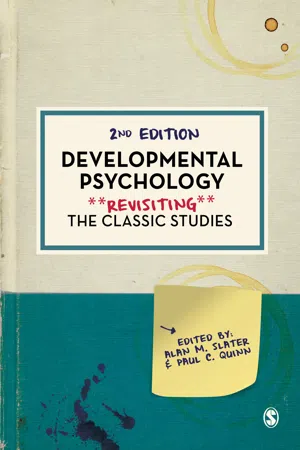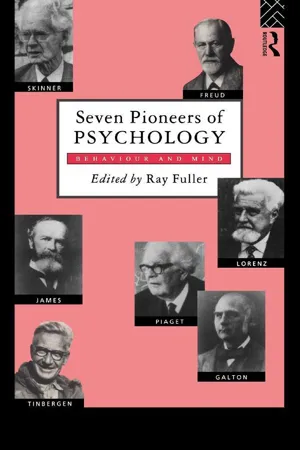Psychology
Baillargeon Explanation of Early Infant Abilities
Baillargeon's explanation of early infant abilities focuses on the concept of object permanence, which is the understanding that objects continue to exist even when they are out of sight. She proposed that infants as young as 3.5 months old possess this understanding, challenging traditional beliefs about infant cognition. Baillargeon's work has had a significant impact on our understanding of early cognitive development in infants.
Written by Perlego with AI-assistance
Related key terms
1 of 5
3 Key excerpts on "Baillargeon Explanation of Early Infant Abilities"
- eBook - ePub
Developmental Psychology
Revisiting the Classic Studies
- Alan M Slater, Paul C Quinn, Alan M Slater, Paul C Quinn(Authors)
- 2020(Publication Date)
- SAGE Publications Ltd(Publisher)
Drawing on the technique of using familiarization, followed by testing with a physically expected but perceptually dissimilar versus physically surprising but perceptually similar event, Baillargeon went on to explore systematically infants’ burgeoning understanding of hidden objects. In particular, she found that between 3.5 and 12 months of age, infants became sensitive to the height (Baillargeon, 1987; Baillargeon & Graber, 1987), location (Baillargeon & Graber, 1988), and solidity of hidden objects (Baillargeon, Graber, DeVos, & Black, 1990). Baillargeon and colleagues also gradually pieced together infants’ understanding of the physical support relations that can exist between objects placed next to or on top of one another (Baillargeon, 2004; Needham & Baillargeon, 1993, 2000). Other researchers have additionally drawn on the VoE method to demonstrate an early understanding of trajectories (Spelke, Breinlinger, Macomber, & Jacobson, 1992; Spelke, Katz, Purcell, Ehrlich, & Breinlinger, 1994), allocentric space (e.g., that an object’s spatial location is not tied to its observer’s location, Kaufman & Needham, 2011), the role of features in individuating objects (e.g., Kaufman & Needham, 2010; Needham & Kaufman, 1997; Wilcox, 1999; Wilcox & Baillargeon, 1998), and even of small number discrimination (Wynn, 1992; Xu & Carey, 1996). This impressive range of precocious abilities led some authors to suggest that object knowledge was largely, if not entirely, present from birth (e.g., Spelke, 1994).Critique of the Classic Study
Together, these findings lead to an apparent discrepancy between the precocious skill demonstrated by Baillargeon and colleagues and the finding famously described by Piaget that infants less than 9 months of age typically will not reach for hidden objects. Several possible explanations have been proposed, many of which take the view that the conclusions of the drawbridge study are a product of “rich interpretation” (Haith, 1998) on the part of the researchers, rather than rich conceptual abilities on the part of young infants, i.e., that there may not be anything “cognitive” underlying the infants’ preferences.For example, Haith (1998) argued that there was always a more parsimonious perceptual explanation for the infants’ responses. This explanation was based on the idea that infants may be insensitive to the occlusion events employed in the previously described experiments. For example, in explaining the drawbridge findings, Haith suggested that infants continue to see the box even once it is visually occluded due to a kind of lingering visual memory trace; and consequently infants look longer at the “impossible” event not because it is impossible but because of the novelty of seeing one physical object pass through another physical object. The infants’ response to novelty, it is argued, need not depend on any physical knowledge at all, but merely on the fact that in the real world objects generally do not appear to pass through other objects unimpeded. - eBook - ePub
- Chris Beckett, Hilary Taylor(Authors)
- 2019(Publication Date)
- SAGE Publications Ltd(Publisher)
Renée Baillargeon (1987) devised an elaborate apparatus whereby a toy car rolled down a track. A screen could be placed in front of part of the track and a box could be placed behind that screen either next to the track or on it, so that it looked as if the car could not get past it. In both cases the car could in fact pass the box. She compared babies’ responses to the apparently ‘possible’ event of the car reappearing from behind the screen when the box had been seen to not be in its way and the apparently ‘impossible’ event of the car seeming to have passed through the box. She found that babies stared for much longer at the apparatus in the ‘impossible’ case. If they had no concept of object permanence, Baillargeon argued, why would the ‘impossible case’ be any more interesting than the other case? Later work by Baillargeon and colleagues, using similar experiments, has continued to explore the way in which infants perceive and interpret objects, and is showing that there are several different cognitive systems involved in interaction with each other (Baillargeon et al., 2011: 41). They have also carried out experiments which show that these very young children can be ‘taught’ to perceive confusing objects and events correctly even though this would normally be beyond what would be expected at their developmental stage (2011: 30). In Vygotsky’s terms this could be seen as an example of learning in the zone of proximal development, with the researchers providing ‘scaffolding’. Other researchers have challenged what Piaget said about ‘egocentricity’ and demonstrated that small children are able to view many types of problem from points of view other than their own (for example, Cox, 1991). It can also be demonstrated that children as young as 2 can make deductions by analogy. This is done by showing children how to do one task with one set of materials, and then giving them another analogous but different task with a different set of materials - eBook - ePub
Seven Pioneers of Psychology
Behaviour and Mind
- R. Fuller(Author)
- 2005(Publication Date)
- Routledge(Publisher)
To summarize: Piaget was a very great developmental psychologist whose influence on the subject surpasses anyone else’s. One of his main contributions was to demonstrate how easy and rewarding it is to do simple experiments on young children’s understanding of quite subtle complex topics. His theory—that logic develops, that it is the product not the engine of development— is controversial; but he was right to raise these claims, and developmental psychology is a better subject for his having done so. The greatest problem about his theory is his idea of the causes of intellectual development. We are very far from knowing how justified is his idea about internal conflict as the main engine of development. We do not even know yet how to test the idea properly—and to compare it with its competitors. And while we wonder what to do about Piaget’s internal conflict perhaps we should remember the great poet Yeats’ remark, ‘We make out of arguments with others, politics, and out of arguments with ourselves, poetry.’ Perhaps the conflicts that Piaget talked so much about had more to do with artistic than with logical mathematical skills. We shall see, or at any rate I hope that we shall see.REFERENCES
Baillargeon, R. (1986) ‘Representing the existence and the location of hidden objects in 6- and 8-month-old infants’, Cognition 23: 21–52.——(1987) ‘Young infants’ reasoning about the physical and spatial characteristics of a hidden object’, Cognitive Development 2: 179–200.Baillargeon, R., Spelke, S. and Wasserman, S. (1985) ‘Object permanence in five-month-old infants’, Cognition 20: 191– 208.Bower, T.G.R. (1971) ‘Objects in the world of the infant’, Scientific American 225: 30–8.——(1982) Development in Infancy, 2nd edn, New York: W.H.Freeman.Bryant, P.E. (1974) Perception and Understanding in Young Children, London: Methuen.——(1990) ‘Empirical evidence for causes in development’, in G.Butterworth and P.Bryant, Causes of Development: Interdisciplinary Perspectives, Hemel Hempstead: Harvester Wheatsheaf.Bryant, P.E. and Trabasso, T. (1971) ‘Transitive inferences and memory in young children’, Nature 232: 456–8.Butterworth, G. (1977) ‘Object disappearance and error in Piaget’s stage IV task’, Journal of Experimental Child Psychology 23: 391–501.Donaldson, M. (1978) Children’s Minds, London: Fontana.——(1982) ‘Conservation: what is the question?’, British Journal of Psychology 73: 199–207.Fuson, K.C. (1988) Children’s Counting and Concepts of Number, New York: Springer-Verlag.Gelman, R. and Gallistel, C.R. (1978) The Child’s Understanding of Number, Cambridge, Mass.: Harvard University Press.Gold, R. (1987) The Description of Cognitive Development: Three Piagetian Themes, Oxford: Clarendon Press.Inhelder, B. and Piaget, J. (1964) The Early Growth of Logic in the Child, London: Routledge and Kegan Paul.Inhelder, B., Sinclair, H. and Bovet, M. (1974) Learning and the Development of Cognition, London: Routledge and Kegan Paul.Johnson, M.H. and Morton, J. (1991) Biology and Cognitive Development, Oxford: Blackwell.Light, P.H., Buckingham, N. and Robbins, A.H. (1979) ‘The conservation task as an interactional setting’, British Journal of Educational Psychology
Index pages curate the most relevant extracts from our library of academic textbooks. They’ve been created using an in-house natural language model (NLM), each adding context and meaning to key research topics.


